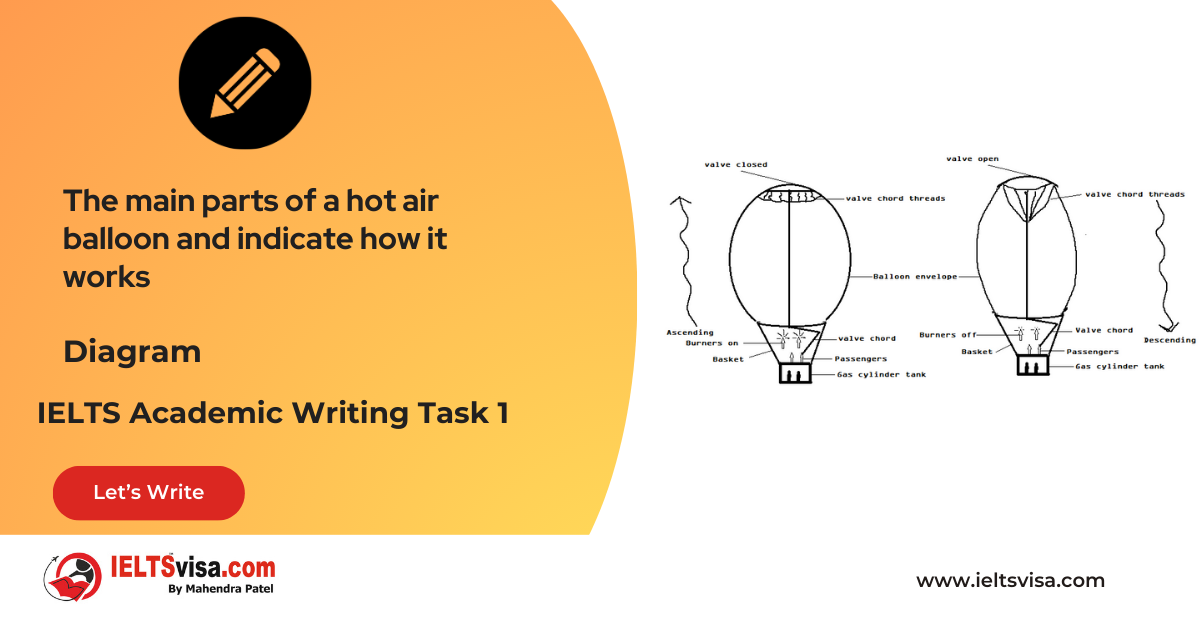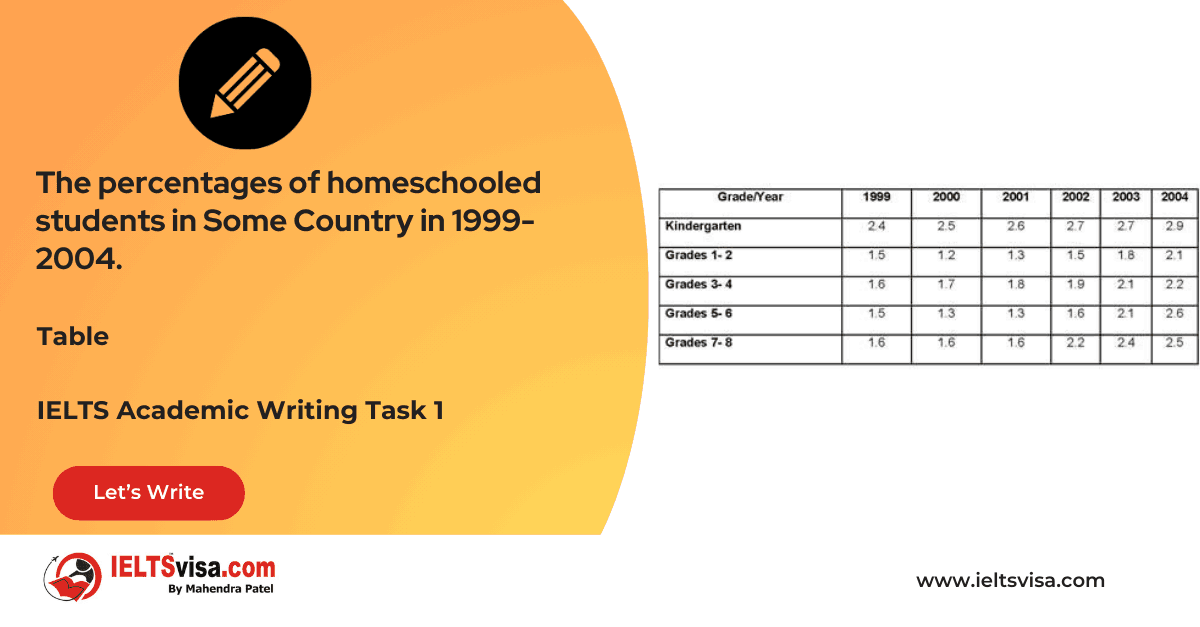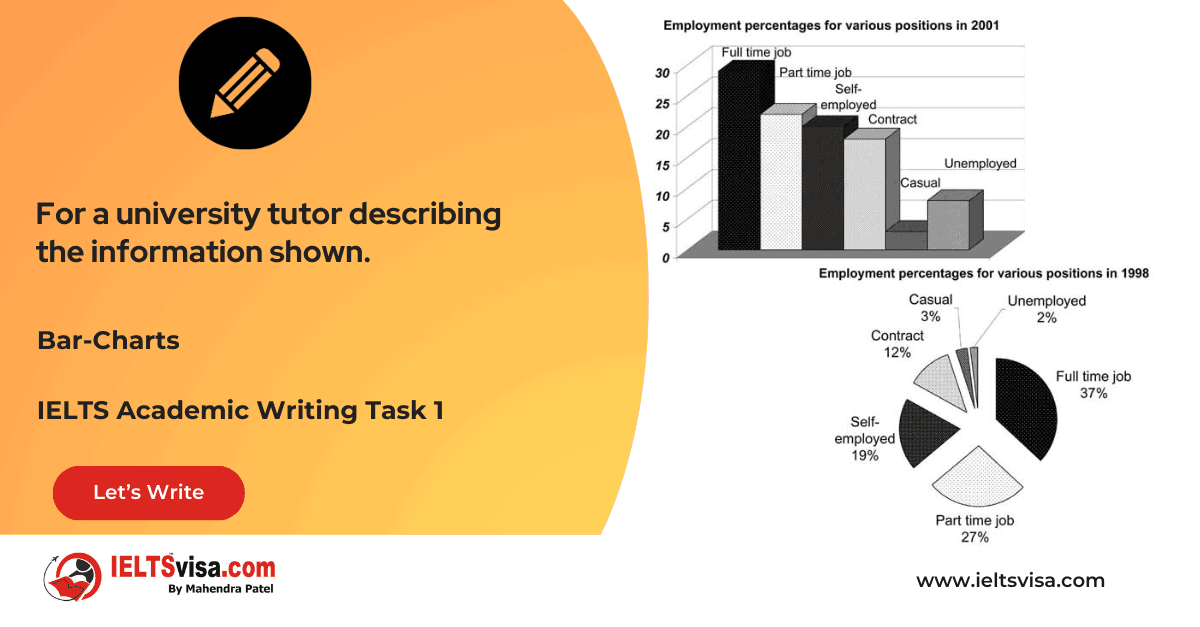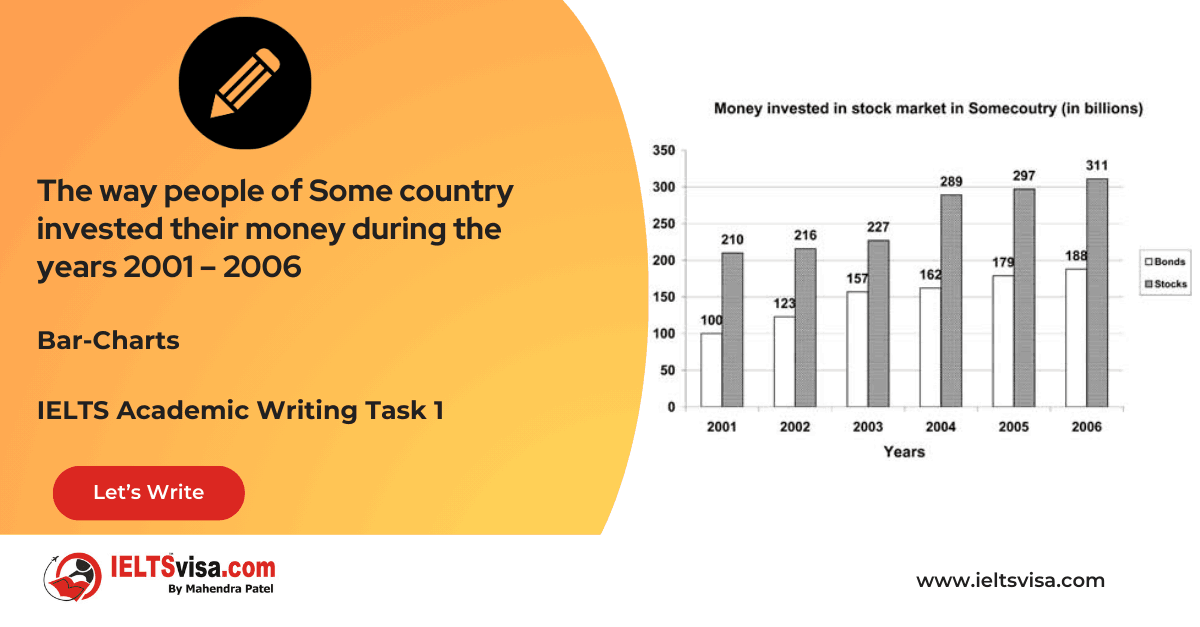The proportion of 14-16 year-old students studying a modern foreign language in an English speaking country, and the top three popular foreign languages
IELTS Academic Writing Task 1 - Bar Graph
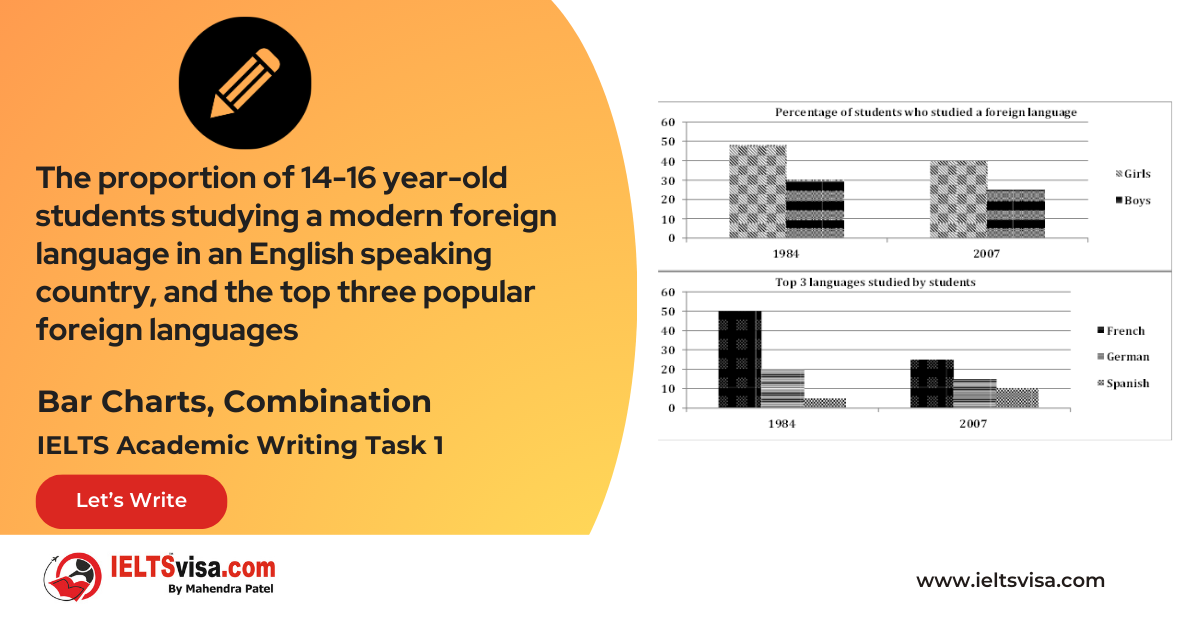
IELTS Writing Task 1 Question
The two bar charts show the proportion of 14-16 year-old students studying a modern foreign language in an English speaking country, and the top three popular foreign languages. Summarize the information by selecting and reporting the main features, and make comparisons where relevant
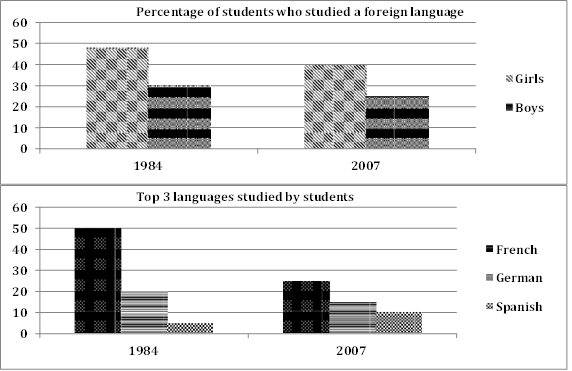
Common Questions for the Bar Graph
1. Graph Type: Bar Charts
2. Title: Proportion of Students Studying Foreign Languages and Most Popular Foreign Languages (1984–2007)
3. What are the units of measurement?: Percentage of students
4. Who: Students aged 14–16 in an English-speaking country
5. When: 1984 and 2007
6.. Where: English-speaking country (unspecified)
7. Topic: Gender differences in foreign language studies and the popularity of specific languages
Comparison Showing and Trends
Comparison 1: Gender Differences in Language Studies
- Details:
- In 1984, 50% of girls and 30% of boys studied foreign languages.
2. By 2007, this fell to 40% of girls and 25% of boys.
Comparison 2 : Popularity of Specific Foreign Languages
- Details:
- French was the most popular in both years, but its popularity declined from 50% in 1984 to 25% in 2007.
2. Germany’s popularity also dropped, from 20% to 15%.
3. Spanish, initially the least popular at 5%, gained popularity and reached 10% by 2007.
Sample Answer
The bar charts illustrate the proportion of 14–16-year-old boys and girls studying modern foreign languages in an English-speaking country and the popularity of the top three foreign languages in 1984 and 2007.
Overall, more girls than boys studied foreign languages, and French was the most popular language despite a significant decline in its popularity.
In 1984, half of the girls studied foreign languages compared to just 30% of boys. By 2007, the proportion had decreased for both genders, with 40% of girls and 25% of boys still engaged in foreign language studies.
Regarding language preferences, French was the most popular, with 50% of students choosing it in 1984. However, this number nearly halved by 2007, falling to 25%. German also saw a decline, dropping from 20% in 1984 to 15% in 2007. In contrast, Spanish gained traction, rising from 5% in 1984 to 10% in 2007, making it the only language that increased in popularity over the period.
Top 29 Vocabularies
| Vocabulary | Type | Meaning | Synonyms | Examples |
| Proportion | Noun | A part or share of a whole | Percentage, Fraction | The proportion of girls studying foreign languages fell to 40%. |
| Decline | Noun/Verb | A decrease in amount or quality | Drop, Reduction | The popularity of French saw a sharp decline over time. |
| Traction | Noun | Gaining popularity or support | Momentum, Appeal | Spanish gained traction among students in 2007. |
| Popularity | Noun | The state of being liked or supported | Favor, Approval | The popularity of German declined over the years. |
| Engage | Verb | To participate in or be involved with | Involve, Enroll | Fewer boys engaged in foreign language studies by 2007. |
| Illustrate | Verb | To explain or show something using visuals or examples | Depict, Demonstrate | “The bar charts illustrate the proportion of students studying foreign languages.” |
| Proportionate | Adjective | Corresponding in size or amount | Balanced, Relative | “The proportionate decrease in boys studying languages is evident over the years.” |
| Studying | Verb | Engaging in academic learning | Learning, Pursuing | “More girls were studying foreign languages compared to boys.” |
| Preference | Noun | A greater liking for one option over another | Choice, Inclination | “French was the top preference for students in 1984.” |
| Declined | Verb | To become smaller or fewer | Reduced, Dropped | “The number of students studying German declined from 1984 to 2007.” |
| Significant | Adjective | Important or notable in size or effect | Substantial, Meaningful | “There was a significant decline in the popularity of French.” |
| Rising | Verb | Increasing in number, level, or importance | Growing, Escalating | “Spanish was the only language with a rising trend in popularity.” |
| Engagement | Noun | The act of being involved in something | Participation, Involvement | “Student engagement in language studies decreased by 2007.” |
| Preference | Noun | A greater liking for one thing over another | Choice, Priority | “French retained its preference among students, although it declined sharply.” |
| Period | Noun | A specific length of time | Duration, Interval | “The analysis covered a period between 1984 and 2007.” |
| Gender | Noun | The state of being male or female | Sex, Classification | “The trend showed clear differences between genders in language studies.” |
| Shift | Noun | A change in position, direction, or focus | Transition, Alteration | “There was a clear shift in the popularity of languages over the years.” |
| Marked | Adjective | Clearly noticeable or distinct | Noticeable, Evident | “Spanish showed a marked increase in popularity by 2007.” |
| Consistently | Adverb | In a steady and predictable manner | Uniformly, Regularly | “Girls consistently outnumbered boys in studying foreign languages.” |
| Engage | Verb | To actively take part in something | Involve, Commit | “Fewer students engaged in learning German compared to French.” |
| Trend | Noun | A general direction of change or development | Pattern, Tendency | “The trend indicates declining interest in German over time.” |
| Comparison | Noun | Examining similarities and differences | Juxtaposition, Contrast | “A comparison of the charts highlights the decline in French’s popularity.” |
| Highlight | Verb | To emphasize something as important | Emphasize, Spotlight | “The data highlights the rising interest in Spanish.” |
| Substantial | Adjective | Of considerable importance, size, or worth | Significant, Meaningful | “There was a substantial reduction in students opting for French.” |
| Popular | Adjective | Widely liked or accepted | Favored, Preferred | “French remained the most popular language despite its decline.” |
| Analyze | Verb | To examine carefully and in detail | Examine, Assess | “The bar charts analyze the changes in language preferences.” |
| Rise | Noun/Verb | An upward movement or increase | Increase, Surge | “The rise in Spanish’s popularity is notable in the given period.” |
| Patterns | Noun | Repeated or regular arrangements or trends | Arrangements, Systems | “Language preferences followed distinct patterns over time.” |
| Retained | Verb | To continue to have or hold | Maintained, Preserved | “French retained its position as the most studied language despite its sharp decline.” |

Our Books
Master IELTS Speaking Part 1
IELTS Writing Task 1 Book
IELTS Writing Task 2 Book
Practice IELTS Other Modules
IELTS Listening
The IELTS Listening test assesses how well you can understand spoken English in various contexts. It lasts about 30 minutes and is divided into four sections with a total of 40 questions. The listening tasks become increasingly difficult as the test progresses.
IELTS Academic Reading
The IELTS Academic Reading section assesses your ability to understand and interpret a variety of texts in academic settings. It is designed to evaluate a range of reading skills, including skimming for gist, reading for main ideas, reading for detail, understanding inferences, and recognizing a writer's opinions and arguments.
IELTS Speaking
The IELTS Speaking test assesses your ability to communicate in English on everyday topics. It lasts 11-14 minutes and consists of three parts: introduction, cue card, and a discussion based on the cue card topic.
IELTS General Reading
IELTS General Reading tests your ability to understand and interpret various types of texts. Here are some key areas and types of content you can expect to encounter in the reading section, along with tips for effective preparation.
IELTS Academic Writing Task 1
In IELTS Academic Writing Task 1, you are presented with a visual representation of information, such as graphs, charts, tables, or diagrams, and you are required to summarize, compare, or explain the data in your own words.
IELTS General Writing Task 1
In IELTS General Writing Task 1, you are required to write a letter based on a given situation. The letter can be formal, semi-formal, or informal, depending on the prompt. Here’s a breakdown of the key components to include in your letter
IELTS Academic Writing Task 2
In IELTS Academic Writing Task 2, you are required to write an essay in response to a question or topic. Here’s a guide to help you understand the essential elements of this task
IELTS Exam Tips
To succeed in the IELTS exam, practice regularly, familiarize yourself with the test format, improve your vocabulary, develop time management skills, and take mock tests to build confidence.
Grammer for IELTS
Grammar is the foundation of effective communication in English. Understanding tense usage, subject-verb agreement, and sentence structure enhances clarity and coherence in writing and speaking.
Vocabulary for IELTS
Vocabulary plays a crucial role in the IELTS (International English Language Testing System) exam, especially in the Speaking and Writing sections. Here’s an overview of why vocabulary is important and how it impacts your performance
RECENT IELTS SAMPLES QUESTIONS AND ANSWERS
Task 1 – Diagram – A conference hall built in 1981 and planned for 2020
20:00 Start Pause Stop [df_adh_heading title_infix="IELTS Writing Task 1 Question" use_divider="on"...
Task 1 – Table – The percentages of homeschooled students in Some Country in 1999-2004.
20:00 Start Pause Stop [df_adh_heading title_infix="IELTS Writing Task 1 Question" use_divider="on"...
Task 1 – Table – For a university tutor describing the information shown.
20:00 Start Pause Stop [df_adh_heading title_infix="IELTS Writing Task 1 Question" use_divider="on"...
Task 1 – Bar-Charts – The way people of Some country invested their money during the years 2001 – 2006
20:00 Start Pause Stop [df_adh_heading title_infix="IELTS Writing Task 1 Question" use_divider="on"...
Task 1 – Diagram – Rainwater Harvesting and Conversion to Drinking Water in an Australian Town.
20:00 Start Pause Stop [df_adh_heading title_infix="IELTS Writing Task 1 Question" use_divider="on"...
Task 1 – Column graph – Percentage of Young People Enrolled in Universities in 2000 and 2007.
20:00 Start Pause Stop [df_adh_heading title_infix="IELTS Writing Task 1 Question" use_divider="on"...

